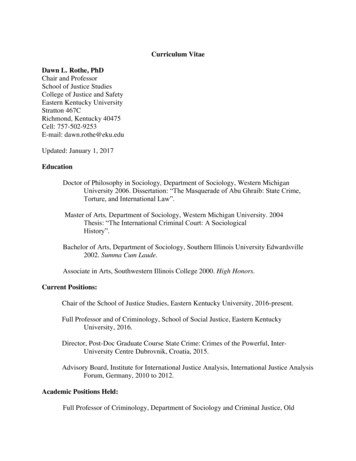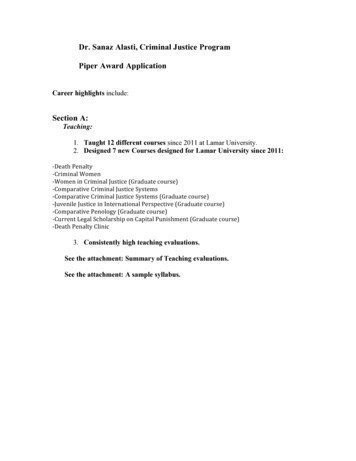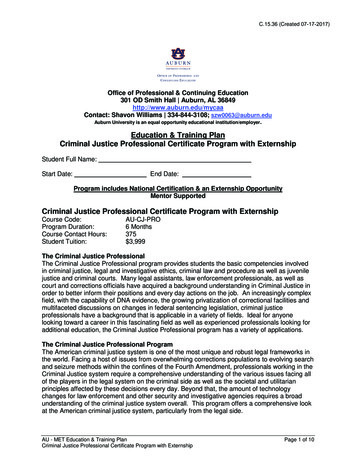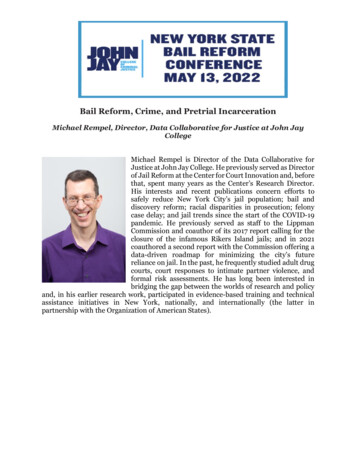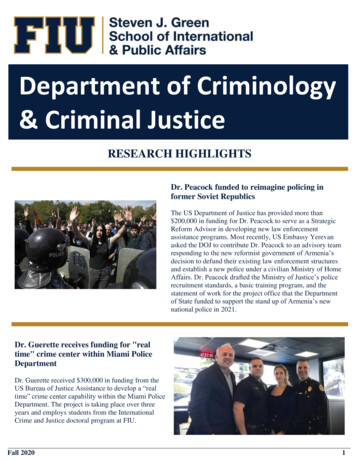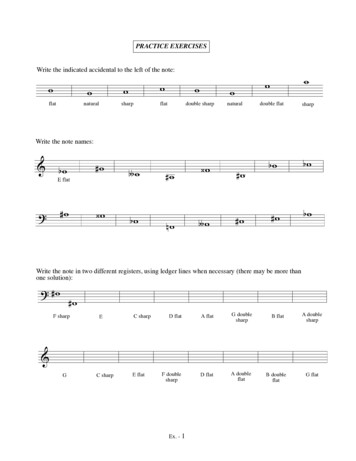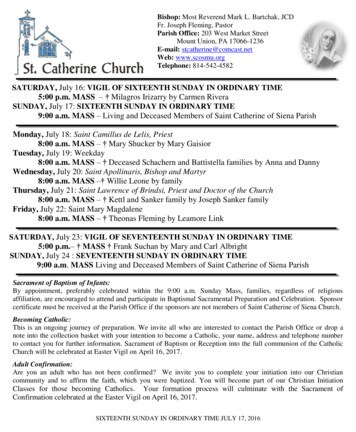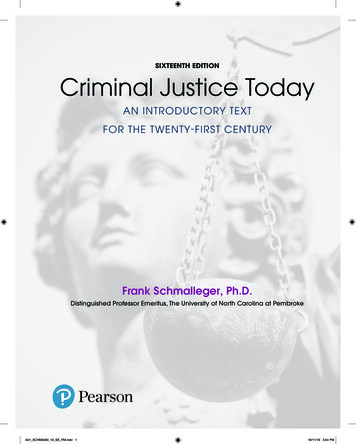
Transcription
SIXTEENTH EDITIONCriminal Justice TodayAN INTRODUCTORY TEXTFOR THE TWENTY-FIRST CENTURYFrank Schmalleger, Ph.D.Distinguished Professor Emeritus, The University of North Carolina at PembrokeA01 SCHM0580 16 SE FM.indd 119/11/19 3:54 PM
Senior Analyst, Content Strategy: Holly ShufeldtProduct Manager: Amy WetzelContent Producer: Faye GemmellaroContent Producer, Digital Studio: Elissa Senra-SargentSenior HE Product Marketer, Revel: Heather TaylorProduct Marketing Assistant: Liz BennettManager, Rights & Permissions: Jenell ForschlerFull-Service Management and Composition: Integra SoftwareServices, Ltd.Full-Service Project Manager: GowthamanSadhanandhamCover Design: Studio MontageCover Photo: travelview/Shutterstock, Stephen Chernin/Getty Images,Photogl/Fotolia, D-Keine/E /Getty Images, Konstantin L/Fotolia,and Jonathan Bachman/REUTERS/Alamy Stock PhotoPrinter/Binder: LSC Communications, Inc.Cover Printer: Phoenix Color/HagerstownText Font: Bembo MT Pro 10/12Credits and acknowledgments for content borrowed from other sources and reproduced, with permission, in this textbook appear on the appropriate page within the text.Acknowledgements of third party content appear on page with the borrowed material, which constitutes an extension of this copyright page.Unless otherwise indicated herein, any third-party trademarks that may appear in this work are the property of their respective owners and anyreferences to third-party trademarks, logos or other trade dress are for demonstrative or descriptive purposes only. Such references are not intendedto imply any sponsorship, endorsement, authorization, or promotion of Pearson’s products by the owners of such marks, or any relationshipbetween the owner and Pearson Education, Inc. or its affiliates, authors, licensees or distributors.The Internet addresses listed in the text were accurate at the time of publication. The inclusion of a website does not indicate an endorsementby the author or Pearson Education. Pearson Education does not guarantee the accuracy of the information presented at these sites.Copyright 2021, 2019, 2017 by Pearson Education, Inc. or its affiliates. All Rights Reserved. Printed in the United States of America.This publication is protected by copyright, and permission should be obtained from the publisher prior to any prohibited reproduction, storage ina retrieval system, or transmission in any form or by any means, electronic, mechanical, photocopying, recording, or otherwise. For informationregarding permissions, request forms and the appropriate contacts within the Pearson Education Global Rights & Permissions department, pleasevisit www.pearsoned.com/permissions/.Many of the designations by manufacturers and sellers to distinguish their products are claimed as trademarks. Where those designations appear inthis book, and the publisher was aware of a trademark claim, the designations have been printed in initial caps or all caps.Library of Congress Cataloging-in-Publication DataNames: Schmalleger, Frank, author.Title: Criminal justice today : an introductory text for the twenty-firstcentury / Frank Schmalleger, Ph.D.Description: Sixteenth edition. Hoboken : Pearson, [2019] Includesbibliographical references and index.Identifiers: LCCN 2019020946 ISBN 9780135770580 ISBN 0135770580Subjects: LCSH: Criminal justice, Administration of—United States. Criminal procedure—United States.Classification: LCC HV9950 .S35 2019 DDC 364.973—dc23 LC record available at CodeAccess Code CardISBN-10:0-13-577053-XISBN-13: 978-0-13-577053-5RentalISBN 10:0-13-577058-0ISBN 13: 978-0-13-577058-0Instructor’s Review CopyISBN 10:0-13-577076-9ISBN 13: 978-0-13-577076-4A01 SCHM0580 16 SE FM.indd 219/11/19 3:54 PM
This book is dedicated to my beautiful wife,Ellen “Willow” Szirandi Schmalleger, my true companion,whose wonderful, happy, and free spiritis a gift to all who know her.A01 SCHM0580 16 SE FM.indd 319/11/19 3:54 PM
Brief ContentsPART 1 Crime in America1Chapter 1 What Is Criminal Justice?Chapter 2 The Crime Picture230Chapter 3 The Search for Causes 70Chapter 4 Criminal LawPART 2 Policing108137Chapter 5 Policing: History and Structure138Chapter 6 Policing: Purpose and OrganizationChapter 7 Policing: Legal Aspects194Chapter 8 Policing: Issues and ChallengesPART 3 Adjudication163240281Chapter 9 The Courts: Structure and ParticipantsChapter 10 Pretrial Activities and the Criminal TrialChapter 11 Sentencing317348PART 4 Corrections397Chapter 12 Probation, Parole, and ReentryChapter 13 Prisons and JailsChapter 14 Prison Life282398428470PART 5 Special Issues509Chapter 15 Juvenile JusticeChapter 16 Drugs and Crime510538Chapter 17 Terrorism, Multinational Criminal Justice, and Global IssuesChapter 18 High-Technology Crimes573608ivA01 SCHM0580 16 SE FM.indd 419/11/19 3:54 PM
ContentsPrefacexxvAcknowledgmentsxxviiiAbout the Author xxxiPART ONECrime in America Chapter 1 What Is Criminal Justice?Introduction123A Brief History of Crime in America4The Theme of This Book 7FREEDOM OR SAFETY? YOU DECIDE Clarence Thomas Says: “Freedom Means Responsibility” 9Criminal Justice and Basic Fairness 10CJ NEWS Surveillance Technology Has Been Blanketing the Nation Since 9-11American Criminal Justice: System and FunctionsThe Consensus ModelThe Conflict Model14Investigation and 9Reentry1313American Criminal Justice: The ProcessPretrial Activities19Due Process and Individual Rights19The Role of the Courts in Defining Rights20The Ultimate Goal: Crime Control through Due ProcessEvidence-Based Practice in Criminal JusticeCJ ISSUES Evidence-Based Practice (EBP) CJ CAREERS Careers in Criminal JusticeThe Start of Academic Criminal Justice2021 222324Multiculturalism and Social Diversity in Criminal JusticeSummary122426Key Terms 27Questions for Review 27Questions for Reflection 27Notes27Chapter 2 The Crime Picture 30Introduction31Crime Data and Social Policy31The Collection of Crime Data32vA01 SCHM0580 16 SE FM.indd 519/11/19 3:54 PM
viCONTENTSThe UCR/NIBRS Program32Development of the UCR Program32The National Incident-Based Reporting SystemHistorical Trends36UCR/NIBRS in TransitionPart I Offenses344041 CJ NEWS “Flash Robs”—A Social Media Phenomenon CJ ISSUES Race and the Criminal Justice SystemPart II Offenses464851FREEDOM OR SAFETY? YOU DECIDE Can Citizens Have Too Much Privacy?The National Crime Victimization SurveyComparisons of the UCR and NCVS525354Special Categories of Crime 55Crime against Women55Crime against the Elderly 56CJ ISSUES Gender issues in Criminal JusticeHate Crime5758Corporate and White-Collar CrimeOrganized CrimeGun Crime596061Drug Crime 62Cybercrime62 CJ ISSUES Gun Control CJ NEWS Most Americans Favor Legalizing MarijuanaTerrorism6465Summary65Key Terms66Questions for Review66Questions for ReflectionNotes636666Chapter 3 The Search for Causes 70Introduction71Criminological Theory72Classical and Neoclassical Theory74Cesare Beccaria: Crime and PunishmentJeremy Bentham: Hedonistic CalculusThe Neoclassical Perspective7777Franz Joseph Gall: PhrenologyA01 SCHM0580 16 SE FM.indd 67676Social Policy and Classical TheoriesEarly Biological Theories767719/11/19 3:54 PM
CONTENTSCesare Lombroso: AtavismCriminal Familiesvii7879William Sheldon: Somatotypes79Social Policy and Early Biological TheoriesBiosocial Theories8080The Gender Ratio ProblemChromosome Theory8081Biochemical Factors and ImbalancesHeredity and HeritabilitySocial Policy and Biological TheoriesPsychological Theories82838484Behavioral Conditioning84Freudian Psychoanalysis 84Psychopathology and CrimeThe Psychotic OffenderTrait Theory858686Psychological ProfilingNeuroscience8788Social Policy and Psychological TheoriesSociological Theories88Social Ecology TheoryAnomie Theory 8989CJ NEWS Evidence of “Warrior Gene” May Help Explain ViolenceSubcultural TheorySocial Process Theories9191CJ ISSUES The Physical Environment and CrimeDifferential Association TheoryRestraint TheoriesLabeling Theory94959597Radical Criminology98Peacemaking Criminology99Social Policy and Conflict TheoriesEmergent Perspectives100Feminist Criminology100Postmodern CriminologySummary9293Social Development and the Life CourseConflict Theories9090Social Policy and Sociological Theories 88100102102Key Terms 103Key CasesA01 SCHM0580 16 SE FM.indd 710319/11/19 3:54 PM
viiiCONTENTSQuestions for Review103Questions for ReflectionNotes104104Chapter 4 Criminal LawIntroduction108109The Nature and Purpose of LawThe Rule of Law109110Types of Law 110 CJ NEWS Politicians Who Violate the “Rule of Law” Get Tough Prison SentencesCriminal Law112Statutory LawCivil Law112113Administrative LawCase Law113113General Categories of 14114114FREEDOM OR SAFETY? YOU DECIDE Should Violent Speech Be Free Speech?Espionage116General Features of Crime116The Criminal Act (Actus Reus)A Guilty Mind (Mens Rea)Concurrence117118120Other Features of Crime120Elements of a Specific Criminal OffenseThe Example of Murder121121The Corpus Delicti of a Crime122Types of Defenses to a Criminal Charge122124JustificationsExcuses124127Procedural DefensesSummary134Key Terms134Key Cases135Questions for Review132135Questions for ReflectionNotes115116Inchoate OffensesAlibi111135135A01 SCHM0580 16 SE FM.indd 819/11/19 3:54 PM
CONTENTSPART TWOPolicing 137Chapter 5 Policing: History and StructureIntroductionix138139Historical Development of the Police139English Roots 139The Early American Experience141The Last Half of the Twentieth CenturyEvidence-Based Policing143144American Policing Today: Federal Agencies 147The Federal Bureau of Investigation 148CJ NEWS The FBI’s Next Generation Identification SystemAmerican Policing Today: State Agencies151American Policing Today: Local Agencies152 CJ NEWS NYPD Permits Wearing of Turban, Beards, by Sikh OfficersPrivate Protective Services153154Integrating Public and Private Security 151157CJ CAREERS 157ETHICS AND PROFESSIONALISM ASIS International Code of EthicsSummary158160Key Terms 160Questions for Review 160Questions for Reflection 160Notes161Chapter 6 Policing: Purpose and OrganizationIntroduction163164The Police Mission 164Enforcing the Law164Apprehending OffendersPreventing Crime165Predicting Crime166Preserving the PeaceProviding Services167168Operational StrategiesPreventive Patrol168168Routine Incident ResponseEmergency Response169Criminal Investigation169Problem SolvingA01 SCHM0580 16 SE FM.indd 916516917119/11/19 3:54 PM
xCONTENTSSupport Services171Managing Police Departments172Police Organization and StructureChain of CommandPolicing Styles172172172The Watchman Style of PolicingThe Legalistic Style of PolicingThe Service Style of Policing174175175Police–Community Relations175FREEDOM OR SAFETY? YOU DECIDE Police Body-Worn Cameras: The Good and the BadTerrorism’s Impact on Policing 180CJ EXHIBIT 6–1 The President’s Task Force on 21st Century PolicingIntelligence-Led Policing and AntiterrorismInformation Sharing and AntiterrorismFusion Centers 183184CJ CAREERS Police Officer185Ethnic and Gender Diversity in PolicingWomen as Effective Police Officers185185187CJ ISSUES Trust and Diversity in Law EnforcementSummary189Key Terms189Questions for Review187189Questions for ReflectionNotes190190Chapter 7 Policing: Legal AspectsIntroduction194195The Abuse of Police Power195A Changing Legal ClimateIndividual Rights196197Due Process RequirementsSearch and Seizure197198The Exclusionary Rule198FREEDOM OR SAFETY? YOU DECIDE Liberty Is a Double-Edged SwordJudicial Philosophy and the U.S. Supreme Court 181182The National Criminal Intelligence Sharing Plan 176CJ ISSUES Plain-View RequirementsDetention and Arrest210Emergency Searches of PersonsA01 SCHM0580 16 SE FM.indd 10206209Searches Incident to ArrestVehicle Searches20020221321319/11/19 3:54 PM
CONTENTS CJ NEWS Supreme Court Says Police Need Warrants before Searching Cell Phones CJ CAREERS School Resource Officer (SRO)Suspicionless SearchesHigh-Technology Searches218219219Police Interrogation220The Right to a Lawyer at Interrogation 214217217The Intelligence FunctionInformantsxi222Suspect Rights: The Miranda Decision223CJ ISSUES The Miranda Warnings225Gathering Special Kinds of Nontestimonial Evidence 228FREEDOM OR SAFETY? YOU DECIDE Policing in the Age of Social MediaElectronic Eavesdropping229230 CJ NEWS Supreme Court Says Police Need Warrant for GPS Tracking CJ ISSUES The USA PATRIOT Act of 2001 and the USA Freedom Act of 2015Summary235Key Terms236Key Cases236231233Questions for Review 236Questions for Reflection 236Notes236Chapter 8 Policing: Issues and ChallengesIntroduction241Police Personality and Culture 240241CJ ISSUES Rightful Policing 243Corruption and Integrity244Money—The Root of Police Evil?Building Police Integrity246246Drug Testing of Police EmployeesProfessionalism and Ethics248249ETHICS AND PROFESSIONALISM The Law Enforcement Code of EthicsEducation and TrainingETHICS AND PROFESSIONALISM The FBI OathRecruitment and SelectionThe Dangers of Police WorkViolence in the Line of Duty250252253253Risk of Disease, Drug Exposure, and Infected EvidenceStress and Fatigue among Police Officers254255FREEDOM OR SAFETY? YOU DECIDE Religion and Public SafetyPolice Use of ForceA01 SCHM0580 16 SE FM.indd 1124925025725819/11/19 3:54 PM
xiiCONTENTSDeadly Force 260CJ EXHIBIT 8–1 Taking Policing to a Higher StandardLess-Lethal Weapons261263 CJ ISSUES California’s Proposed Lethal Force Standard CJ ISSUES The President’s Task Force on 21st Century Policing, Part 2Discretion and the Individual Officer265Racial Profiling and Biased Policing265 263264CJ NEWS Is the Video Recording of Police Activity in a Public Place Legal?266FREEDOM OR SAFETY? YOU DECIDE Was the NYPD’s Monitoring of Muslim Groups a Form of Religious Profiling? 269Racially Biased PolicingPolice Civil Liability270270Common Sources of Civil SuitsFederal Lawsuits271272FREEDOM OR SAFETY? YOU DECIDE Law Enforcement and Data EncryptionSummary276Key Terms277Key Cases277Questions for Review277Questions for ReflectionNotes277277PART THREE Adjudication281Chapter 9 The Courts: Structure and ParticipantsIntroductionThe State Court SystemState Court Systems TodayThe Federal Court SystemU.S. District Courts284285289289U.S. Courts of Appeals290The U.S. Supreme Court291The Courtroom Work Group293294The Prosecuting Attorney296CJ CAREERS Assistant District Attorney 297The Defense Counsel 283284The Development of State CourtsThe Judge282283History and Structure of the American Court System 273299CJ ISSUES Gideon v. Wainwright and Indigent DefenseA01 SCHM0580 16 SE FM.indd 1230219/11/19 3:54 PM
CONTENTSThe Bailiff304Trial Court Administrators304ETHICS AND PROFESSIONALISM American Bar Association’s Model Rules of Professional ConductThe Court ReporterThe Clerk of CourtExpert Witnesses xiii305305306306CJ NEWS DNA Sampling Solves Some of the Toughest CasesOutsiders: Nonprofessional Courtroom Participants307308Lay Witnesses 308Jurors309The Victim310The Defendant311Spectators and the PressSummary311312Key Terms 313Key Cases313Questions for Review 313Questions for Reflection 313Notes313Chapter 10 Pretrial Activities and the Criminal TrialIntroduction318Pretrial Activities318The First Appearance 318CJ CAREERS Surety AgentThe Grand JuryArraignment and PleaPlea Bargaining321324The Preliminary Hearing 325326326CJ ISSUES Nonjudicial Pretrial Release DecisionsThe Criminal TrialStages in a Criminal Trial329331Opening Statements334The Presentation of Evidence334CJ ISSUES Pretrial and Post-Trial MotionsClosing Arguments338339The Judge’s Charge to the Jury340Jury Deliberations and the Verdict 328329Trial Initiation: The Speedy Trial ActJury Selection327328Nature and Purpose of the Criminal Trial 317340CJ NEWS Social Media Pose New Threats to Keeping Jurors Isolated during TrialsA01 SCHM0580 16 SE FM.indd 1334119/11/19 3:54 PM
xivCONTENTSImproving the Adjudication Process342 CJ ISSUES Courtrooms of the Future CJ ISSUES The Bilingual Courtroom 344Summary343345Key Terms 345Key Cases345Questions for Review345Questions for ReflectionNotes345346Chapter 11 SentencingIntroduction348349The Philosophy and Goals of Criminal 0351RehabilitationRestoration351351Indeterminate Sentencing353Explanation of Indeterminate SentencingCritiques of Indeterminate SentencingStructured Sentencing 353353354CJ ISSUES Aggravating and Mitigating CircumstancesFederal Sentencing GuidelinesThree-Strikes Laws358360Mandatory Sentencing360Sentencing and Today’s Prison Crisis362CJ CAREERS Medicolegal Death InvestigatorInnovations in SentencingJustice Reinvestment 356356The Legal Environment of Structured Sentencing 349363364365CJ ISSUES Justice Reinvestment 366The Presentence Investigation366The Victim—Forgotten No Longer367Victims’ Rights 368 CJ ISSUES Victims’ Rights in CaliforniaVictim-Impact StatementsTraditional Sentencing OptionsSentencing RationalesSentencing PracticesA01 SCHM0580 16 SE FM.indd 1436937037037137119/11/19 3:54 PM
CONTENTSFinesxv373Death: The Ultimate Sanction 373Habeas Corpus Review375FREEDOM OR SAFETY? YOU DECIDE What Are the Limits of Genetic Privacy? 377Opposition to Capital Punishment 378CJ NEWS High Costs Lead to Reconsideration of Death PenaltyJustifications for Capital PunishmentThe Courts and the Death PenaltyThe Future of the Death Penalty 383384385388CJ NEWS Death-Row Exonerations Based on DNA Expose Flaws in Legal SystemSummary389Key Terms390Key Cases390388Questions for Review 390Questions for Reflection 390Notes391PART FOURCorrections 397Chapter 12 Probation, Parole, and ReentryIntroduction398399What Is Probation? 399The Extent of ProbationProbation ConditionsFederal Probation400400401FREEDOM OR SAFETY? YOU DECIDE Special Conditions of ProbationWhat Is Parole?402The Extent of ParoleParole Conditions 403404CJ ISSUES Culturally Skilled Probation OfficersFederal ParoleAdvantages of Probation and ParoleThe Challenges of the Job409409411CJ CAREERS Probation OfficerA01 SCHM0580 16 SE FM.indd 15406407The Job of Probation and Parole OfficersIntermediate Sanctions406406Disadvantages of Probation and ParoleThe Legal EnvironmentSplit Sentencing404405Probation and Parole: The Pluses and Minuses 40241141219/11/19 3:54 PM
xviCONTENTSShock Probation and Shock ParoleShock Incarceration412413Mixed Sentencing and Community Service413Intensive Supervision of Probationers and Parolees414ETHICS AND PROFESSIONALISM American Probation and Parole Association Code of EthicsHome Confinement and Remote Location Monitoring Changes in Reentry Policies 415CJ NEWS How GPS Technology Keeps Track of Sex OffendersThe Future of Probation and Parole419422The Reinvention of Probation and Evidence-Based Practices423Key Terms424Key Cases424Questions for Review424424Chapter 13 Prisons and 28429Early Punishments430430Public HumiliationWorkhousesExile422424Questions for ReflectionNotes417418CJ ISSUES Remote Reporting ProbationSummary414430431431The Emergence of Prisons 432The Penitentiary Era (1790–1825)432The Mass Prison Era (1825–1876)434The Reformatory Era (1876–1890)434 CJ ISSUES Chaplain James Finley’s Letter from the Ohio Penitentiary, 1850 CJ ISSUES An Early Texas PrisonThe Industrial Era (1890–1935)The Punitive Era (1935–1945)436436439The Treatment Era (1945–1967)439The Community-Based Era (1967–1980)The Warehousing Era (1980–1995)The Just Deserts Era (1995–2012)440441443The Evidence-Based Era (2012–Present) 444CJ ISSUES Evidence-Based CorrectionsA01 SCHM0580 16 SE FM.indd 1643544419/11/19 3:54 PM
CONTENTSPrisons Today445Overcrowding 446CJ ISSUES Who’s in Prison and Why?Security Levels447449Prison Classification SystemsThe Federal Prison System 450451CJ ISSUES The Charles Colson Task Force on Federal CorrectionsRecent ImprovementsJailsxvii455456457Women and Jail458The Growth of Jails458FREEDOM OR SAFETY? YOU DECIDE To What Degree Should the Personal Values of Workers in the Criminal Justice SystemInfluence Job Performance? 459Direct-Supervision JailsJails and the Future460460Private Prisons 462ETHICS AND PROFESSIONALISM American Jail Association Code of Ethics for Jail Officers CJ ISSUES Arguments for and against the Privatization of PrisonsSummary465Key Terms465Key Names462463465Questions for Review 465Questions for Reflection 466Notes466Chapter 14 Prison LifeIntroduction470471Research on Prison Life—Total InstitutionsThe Male Inmate’s World472The Evolution of Prison SubculturesThe Functions of Prison SubculturesPrison Lifestyles and Inmate Types 471473474474CJ EXHIBIT 14-1 Prison Argot: The Language of ConfinementHomosexuality and Sexual Victimization in PrisonThe Female Inmate’s WorldParents in Prison477478480Gender ResponsivenessInstitutions for Women 475481481CJ ISSUES The Bangkok Rules on the Treatment of Female PrisonersSocial Structure in Women’s PrisonsA01 SCHM0580 16 SE FM.indd 1748248319/11/19 3:54 PM
xviiiCONTENTSTypes of Female Inmates483Violence in Women’s PrisonsThe Staff World484484The Professionalization of Corrections Officers485Security Threat Groups and Prison Riots 486ETHICS AND PROFESSIONALISM American Correctional Association Code of EthicsPrisoners’ Rights487488The Legal Basis of Prisoners’ RightsGrievance Procedures490491A Return to the Hands-Off Doctrine?495FREEDOM OR SAFETY? YOU DECIDE Should Prison Libraries Limit Access to Potentially Inflammatory Literature? 496Issues Facing Prisons TodayGeriatric Offenders498498Mentally Ill and Intellectually Disabled InmatesTerrorism and Corrections500501 CJ ISSUES Technocorrections 502 CJ NEWS Radical Islam, Terrorism, and U.S. Prisons503FREEDOM OR SAFETY? YOU DECIDE Censoring Prison CommunicationsSummary504504Key Terms 505Key Cases505Questions for Review505Questions for ReflectionNotes505505PART FIVESpecial Issues Chapter 15 Juvenile JusticeIntroduction510511Juvenile Justice throughout HistoryEarliest Times512512The Juvenile Court Era513Categories of Children in the Juvenile Justice System CJ NEWS Schools Take Bullying SeriouslyThe Legal Environment515516516Legislation concerning Juveniles and JusticeThe Legal Rights of Juveniles518519The Juvenile Justice Process Today 509520CJ ISSUES The Juvenile Justice System versus Criminal Case ProcessingAdult and Juvenile Justice ComparedA01 SCHM0580 16 SE FM.indd 1852152119/11/19 3:54 PM
CONTENTSHow the System Works522Intake and Detention HearingsAdjudicationDisposition522525525 CJ ISSUES Juvenile Courts versus Adult Courts CJ NEWS Justice-Involved Girls CJ CAREER PROFILE Juvenile Justice ProfessionalPostadjudicatory Review529530531CJ ISSUES Evidence-Based Juvenile JusticeSummary527531Trends in Juvenile Justice xix533535Key Terms 536Key Cases536Questions for Review 536Questions for Reflection 536Notes536Chapter 16 Drugs and CrimeIntroduction538539Drugs and Drug AbuseDrug Crime539540What Is a Drug?540A History of Drug Abuse in AmericaDrug Use and Social AwarenessAntidrug Legislation542543544The Investigation of Drug Abuse and ManufacturingThe Most Common Drugs—And Who Is Using ThemDrug TraffickingMarijuana 551551CJ ISSUES Drugs: What’s in a Name?CocaineHeroin552553553MethamphetamineClub Drugs 549550554555CJ NEWS “Bath Salts” Drugs: Very Potent, Hard to Target556The Costs of Abuse 557The Indirect Costs of AbuseDrug-Related Crime558Solving the Drug ProblemStrict Law EnforcementAsset ForfeitureA01 SCHM0580 16 SE FM.indd 1955856056156119/11/19 3:54 PM
xxCONTENTSInterdiction563Crop Control563Prevention and TreatmentSummary568Key Terms569Key Cases569Questions for Review569Questions for ReflectionNotes564569569Chapter 17 Terrorism, Multinational Criminal Justice, and Global IssuesIntroduction574Ethnocentrism and the Study of Criminal JusticeProblems with DataThe Hudud CrimesThe Tazir CrimesIslamic Courts574575Islamic Criminal Justice576577579579International Criminal Justice Organizations579The Role of the United Nations in Criminal JusticeInterpol and Europol580581The International Criminal CourtGlobalization and Crime583584Transnational Organized Crime585Human Smuggling and TraffickingTerrorism586588 CJ ISSUES Lone-Wolf Terrorism and the Radicalization Process 589 CJ ISSUES What Is Terrorist Activity?Types of Terrorism590Causes of Terrorism591595Combating Terrorism 595CJ ISSUES The USA PATRIOT Act of 2001 (as Amended and Reauthorized)Foreign Terrorist OrganizationsSummary603Key Terms604Questions for Review597600The Future of International Terrorism603604Questions for ReflectionNotes573604605A01 SCHM0580 16 SE FM.indd 2019/11/19 3:54 PM
CONTENTSChapter 18 High-Technology CrimesIntroduction608609Technology and CrimeBiocrime609610Cybercrime611Terrorism and Technology615Technology and Crime Control615Leading Technological Organizations in Criminal JusticeCriminalistics: Past, Present, and FutureNew Technologies in Criminalistics 617618620CJ NEWS Microbial Communities on Skin Leave Unique Traces at Crime ScenesOn the Horizon621627The Future of Criminal JusticeSummaryxxi630631Key Terms 631Key Cases632Questions for Review 632Questions for Reflection 632Notes632List of AcronymsGlossary636639Case Index663Name IndexSubject IndexA01 SCHM0580 16 SE FM.indd 2166767519/11/19 3:54 PM
New to This EditionChapter-Specific ChangesChapter 1: What Is Criminal Justice? A new key term, “procedural justice,” has been added tothe chapter.The discussion of “new era” crime has been expanded.Mention is now made of the criminal proceedings againstBill Cosby.The chapter’s statistics have been updated.Two new key terms, “evidence-based,” and “evidencebased practice (EBP),” have been added to the chapter.Chapter 2: The Crime Picture A new key term, “unreported crime,” has been added tothe chapter.Updated crime statistics are found throughout thechapter.The discussion of underreported and unreported crimehas been expanded.An enhanced discussion of NIBRS is now part of thechapter.A brief discussion of the Parkland High School shootingin Florida has been added.Chapter 3: The Search for Causes Discussion of rappers Jimmy Wopo and XXXTentacionhave been added to the chapter, along with expandedcoverage of Suge Night’s legal difficulties.A new key term, “neuroscience,” has been added to thechapter and defined.Chapter 4: Criminal Law Information on the insanity defense has been updated.In the list of types and levels of crimes, the word “infraction” has replaced “offense.”Chapter 5: Policing: Historyand Structure The boxed lists of police and private security agencies hasbeen updated.Chapter 6: Policing: Purposeand Organization A discussion of LEEP, the online gateway that provideslaw enforcement agencies and other criminal justice entities with access to a wealth of beneficial resources hasbeen added.A new key term, “fusion center,” has been added.Chapter 7: Policing: Legal Aspects Two new key terms, “warrantless search,” and “investigative detention,” have been added to the chapter.The U.S. Supreme Court’s distinction between threetypes of Fourth Amendment police-citizen interactionhas been added: (1) consensual encounters, (2) detentions,and (3) arrest.The U.S. Supreme Court case of Carpenter v. U.S.,involving police access to cell phone records, is nowdiscussed.A new U.S. Supreme Court case dealing with rental vehicles is now discussed. A graphic showing state wiretap authorizations is a part of the discussion.Chapter 8: Policing: Issuesand Challenges Police subculture is now shown to be equivalent to p oliceoccupational culture, and the discussion of police subculture has been expanded.The story is told about corruption among members ofthe Baltimore Police Department’s Gun Trace Task Force(GTTF).Police training standards have been updated.The 2018 Law Enforcement Mental Health and WellnessAct is now described.A 2018 article published in the American Journal of PreventiveMedicine that found that members of the police professionare more likely to sustain nonfatal work-related injuriesthan members of any other occupation is now discussed.The proper handling of fentanyl at crime scenes isdiscussed.Statistics and line art have been updated throughout thechapter.xxiiA01 SCHM0580 16 SE FM.indd 2219/11/19 3:54 PM
NEW TO THIS EDITION The 2017 Supreme Court case of White v. Pauly, in whichthe Court established that “Qualified immunity attacheswhen an official’s conduct does not violate clearly established statutory or constitutional rights of which a reasonable person would have known,” has been added.Chapter 9: The Courts: Structureand Participants A discussion of the trial of drug lord “El Chapo” Guzmanis now a part of the chapter. xxiiiThe concept of a term of supervised release (TSR) ismore clearly defined.Bill Cosby’s use of an ankle bracelet while awaiting theconclusion of his trial is discussed.Efforts made by the federal government to strengthenBOP reentry efforts are discussed.The 2018 federal First Step Act is discussed, as is the federal Second Chance Act.Chapter 13: Prisons and JailsA new figure, Figure 13-4, “Prison and Jail Populationsin the United States,” has been added. Statistics have been updated throughout the chapter. The term “new generation jail” has been changed to“ direct-supervision jails.” Chapter 10: Pretrial Activities andthe Criminal Trial The bail reform movement that is currently underway inthe U.S. is discussed.The discussion of recidivism has been expanded andclarified.Chapter 14: Prison Life Chapter 11: SentencingA new section, “Explanation of Indeterminate Senten cing,” has been added. Details of a new report from the National Council onCrime and Delinquency (NCCD) have been added. Proposed federal laws that would reduce sentences formany inmates
Criminal Justice and Basic Fairness 10 CJ NEWS Surveillance Technology Has Been Blanketing the Nation Since 9-11 12 American Criminal Justice: System and Functions 13 The Consensus Model 13 The Conflict Model 14 American Criminal Justice: The Process 15 Investigation and Arrest 15 Pretrial Activities 16 Adjudication 18 Sentencing 18


